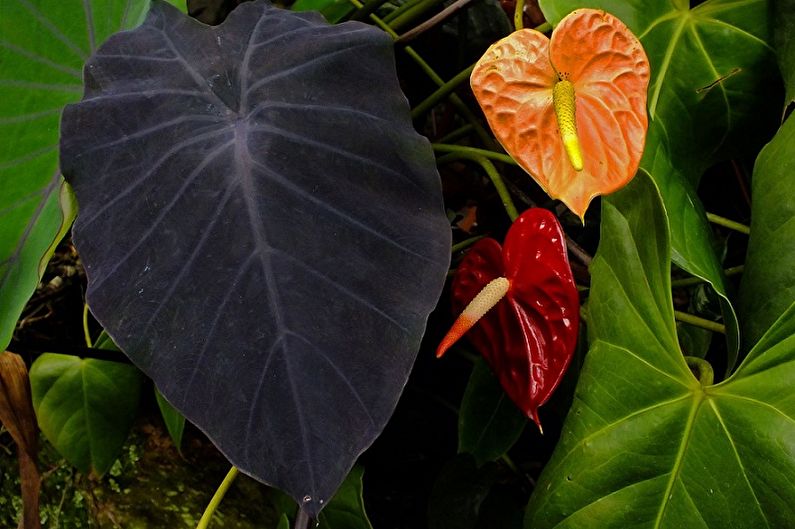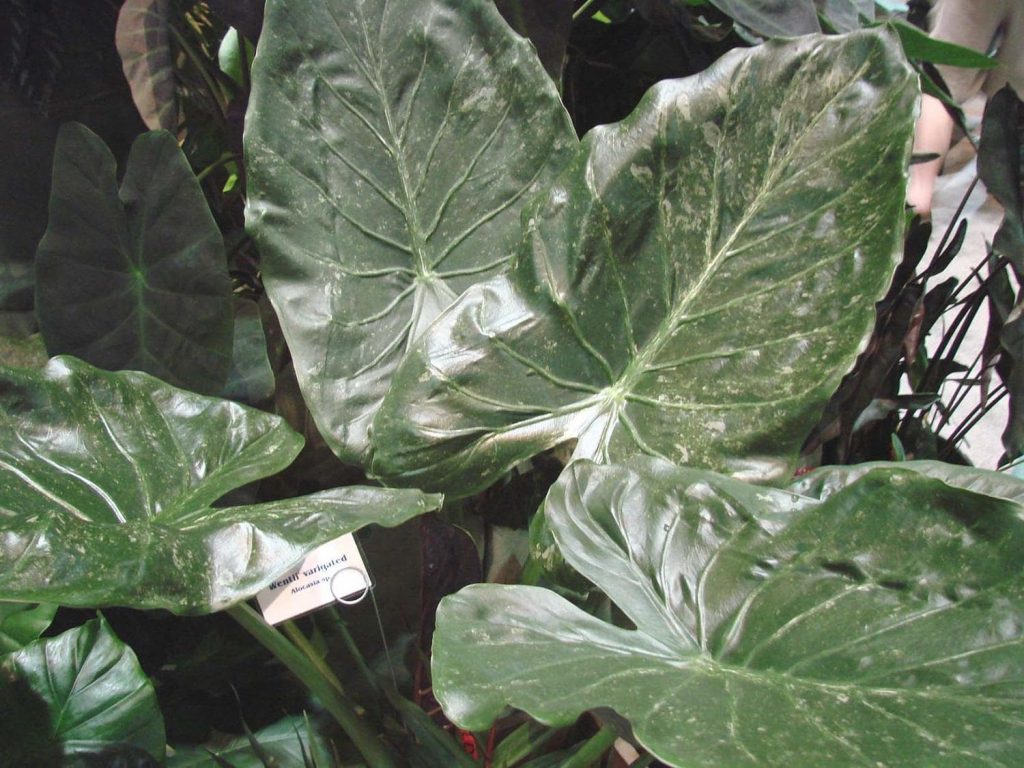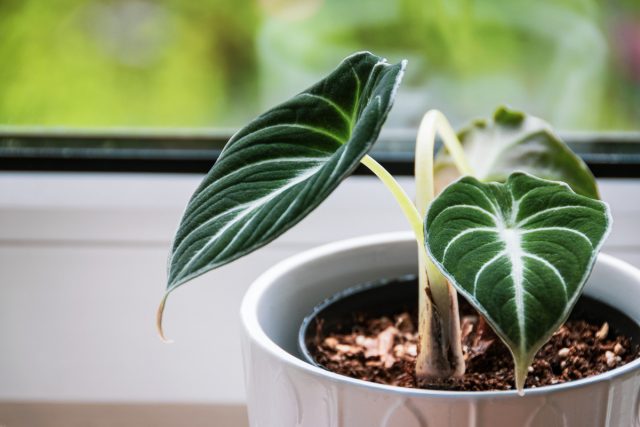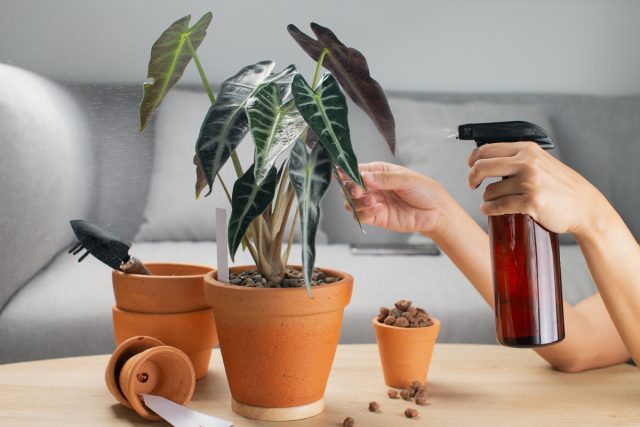Alocasia Wentii from the Aroid family ( Araceae ) received the eloquent nicknames “elephant”, “elephant ears” and “African mask” for the size and shape of the leaves.
Alocasia Wentii in rooms rarely exceed 1 m in height and almost always retain leaves for the winter. These are evergreen large-leaved stars with a thick, short, upright stem and a stolon-like or tuberous rhizome.
Usually on one Alocasia Wentii plant with a good content, you can admire the 6th – 8th leaves. The Alocasia Wentii plant produces about one leaf per month.
The leaves are very large, lobed, thyroid, densely leathery, from 20-30 cm to 80 cm in length, on powerful petioles 30-100 cm high with long sheaths.

The unclear shape and color of young leaves are replaced by an arrow- or heart-shaped with very large teeth along the edges – in adults. The strong gloss of the leaves emphasizes the undulating curves of the surface.
In some species, the color is light and uniform, in others, it is almost black with thick contrasting veins. The pattern of the veins is special:
The petiole is divided into three central veins (the main one and towards the lateral segments), and the secondary veins create a feather pattern, merging into the marginal border. On the leaves, there are hydathodes – water stomata that release drops of water when waterlogged.
Alocasia Wentii rarely blooms in rooms. Inflorescences are hidden in the mass of leaves, not exceeding the petioles in height. Cobs of greenish color are hidden by a veil with a small constriction. Hemispheres of red berries are an even rarer sight.
Alocasia, especially rhizomes, must be handled very carefully. Toxic substances can cause both severe irritation and poisoning.
Table of Contents
Alocasia Wentii Sisters (Other Varieties)
Alocasia sander ( Alocasia sanderiana ) is a favorite, famous for thick white veins on a very dark background of leaf plates that create a strict pattern. Height – up to 60 cm.
Alocasia copper-red ( Alocasia cuprea ) – a compact species with a shortened or underground shoot, attracting with a metallic effect and more elongated arrow-shaped leaves.

Alocasia fragrant ( Alocasia odora ) is a powerful, up to 1 m species with a tuberous rhizome and very large long-petiolate, wavy-heart-shaped leaves. It is represented in the rooms mainly by spotted variegated forms.
Alocasia mortfontanskaya ( Alocasia × mortfontanensis) , still better known as Amazonian alocasia ( Alocasia x amazonica ) is a hybrid with wavy shield-like leaves, contrasting thick veins and shortened stems.
The range of alocasia varieties is constantly expanding with less capricious, compact hybrids with interesting colors:
- “Polly” ( Polly ) – dark-leaved and small-leaved variety with the thickest white veins.
- “Calidora” ( Calidora ) – light-leaved wrinkled hybrid.
- ‘Portodora’ is a hybrid with glossy bright green leaves with serrated edges.
- “Red Secret” ( Red Secret ) – a copper variety with a pinkish bloom, burgundy underside, and recessed, feathery, dark green veins.
- ‘Bambino’ ( Bambino ) is a compact variety with neat spear-shaped whole leaves and very thick white veins.
- “Silver Green” ( Silver Green ) – silver-gray, with a reddish reverse side of arrow-shaped leaves hybrid.
- “Alocasia Black Velvet” ( Black Velvet ) – a compact variety up to 30 cm high with almost round wavy black-green leaves, thin luminous veins, and a purple reverse side. You can learn all about caring for Alocasia Black Velvet in its special and detailed care guide. Read more now!
- “Dragon Scale” ( Dragon Scale ) – light-leaved variety with thin veins – dark above and purple below.
If you have a place for alocasia in a spacious greenhouse, then you can also consider a giant, with leaves up to 1 m, large-rhizome alocasia ( Alocasia macrorrhizos ) or edible, with short-pointed leaves, alocasia klobuchkovy ( Alocasia cucullata ).
Growing Conditions for Indoor Alocasia Wentii
Tropical requests of Alocasia Wentii are easier to satisfy in greenhouses or flower showcases. Plants in living rooms are especially affected from autumn to spring. For them, you need to monitor the heat and compensate for the lighting.
Lighting and Placement
Alocasia Wentii – lovers of stable and constant soft lighting, without direct sun. In summer, it is better to place them in soft penumbra, on the northern windowsill or not far from brighter windows, in winter – on the brightest window sill to compensate for the reduction in daylight hours.
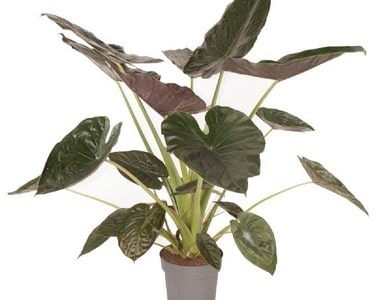
Green-leaved plants are more shade-tolerant, and variegated plants are quite photophilous.
Temperature and Ventilation
Alocasia Wentii is so thermophilic that even in winter it is better to limit the minimum temperatures to 18-19 degrees Celsius.
Indicators from 20 to 22 degrees for hybrid varieties and from 22 to 25 degrees for species alocasia all year round are ideal for this culture, which does not tolerate inconstancy.
Alocasia Wentii must be protected from drafts and temperature changes all year round. The place should be protected, warm, and stable.
Alocasia Wentii Care at Home
Maintaining a light but constant substrate moisture and very high air humidity is not an easy task, but for Alocasia Wentii this is the only way to create ideal care.
Watering and Humidity
Even a slight waterlogging leads to the rotting of the roots of Alocasia Wentii, and drying out leads to the loss of leaves. The water in the pans should not stagnate for even an extra minute, the released water must be drained immediately.
To establish the optimal frequency of watering, it is better to get an indicator or by touch to check the degree of drying of the soil, irrigating as soon as 5 cm dry on top of the soil (and in winter – in a day).
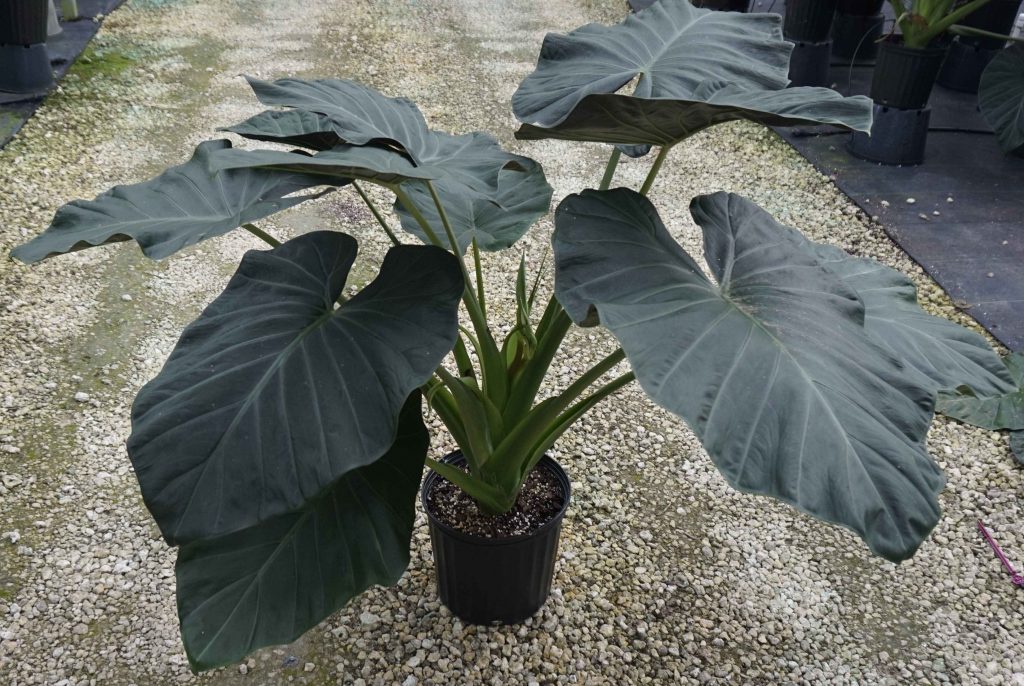
Alocasia Wentii plants are watered only with soft, slightly tepid water. Alocasia Wentii needs frequent spraying, but usually, a fairly stable humidity can only be created by installing a humidifier, a cap, a showcase, a florarium, or at least a tray with pebbles. Optimum humidity indicators are not lower than 75%.
Leaves should be kept clean by dusting at least once a week with a soft, damp sponge or cloth.
Top Dressing and Fertilizer Composition for Alocasia Wentii
Only special fertilizers for Aroids are ideal for Alocasia Wentii, but they can be replaced with fertilizers for succulents or a half-reduced dose of fertilizers for ornamental leafy plants.
Regular top dressings (every 2 weeks, in spring and summer) or long-acting fertilizers (according to instructions) are suitable. In autumn and winter, Alocasia Wentii is not fed.
Pruning, Transplanting, Containers, and Substrate
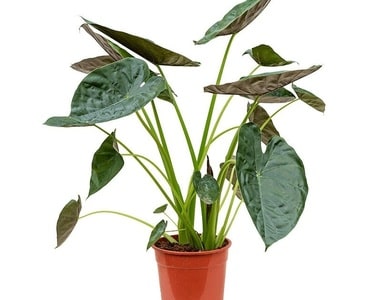
The leaves are cut only after complete yellowing, to the base (as in bulbous ones).
Even young Alocasia Wentii plants are best repotted every two years, rather than annually, as the roots grow. The safest time is the beginning of growth, February-March.
Ideal characteristics provide a special substrate for Aroid or epiphytic plants – coarse, fibrous, and slightly acidic. Orchid soil can be used by mixing it with a universal substrate and sphagnum.
When mixing home soil mixtures, you can combine 2 parts leafy soil, 1 part sphagnum or coconut substrate, 1 part soddy soil, 1 part peat, and 1 part coarse sand, adjusting the texture of the bark.
Alocasia Wentii plants need fairly close, deep pots with good drainage holes. The step of increasing the capacity during transplantation is 2-3 cm.
High drainage (about 5 cm) must be laid at the bottom. Alocasia Wentii rolls over with the preservation of an earthy coma. The tops of the tubers are left above the soil.
Diseases, Pests, and Problems in Growing Alocasia Wentii
All problems are associated with a violation of the stability of conditions – heat and high humidity, irregular watering.
Alocasia Wentii suffers greatly from spider mites, especially red ones. But not uncommon on plants in a weakened state and aphids, thrips, and whiteflies.
Tomato leaf infusion and bioinsecticides are the best options to deal with them. But if they do not help stop the rapid spread of insects, it is worth starting treatment with appropriate chemicals (for example, Decis for ticks and Actellik for aphids).
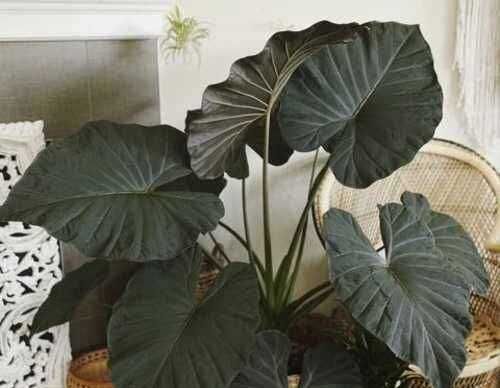
Reproduction of Alocasia Wentii
Options for obtaining offspring depend on the condition and age of the plant. The easiest way is to wait until the Alocasia Wentii grows, releases shoots and the leaves that form in a large number of daughter tubers begin to grow – and separate strong offspring with their own roots during transplantation.
If you don’t want to wait, small daughter nodules without roots and leaves can be rooted separately by carefully selecting them from the soil or removing them from the roots during transplantation.
For rooting, they are planted in greenhouses, under a cap or in a closed container, in sphagnum, perlite, and light soil. Lower heating, high humidity, and very careful watering are desirable.
After the appearance of the roots, the Alocasia Wentii plants are planted according to the standard rules in small pots (slightly larger than the nodules themselves), later turning over after the roots have completely mastered the substrate.
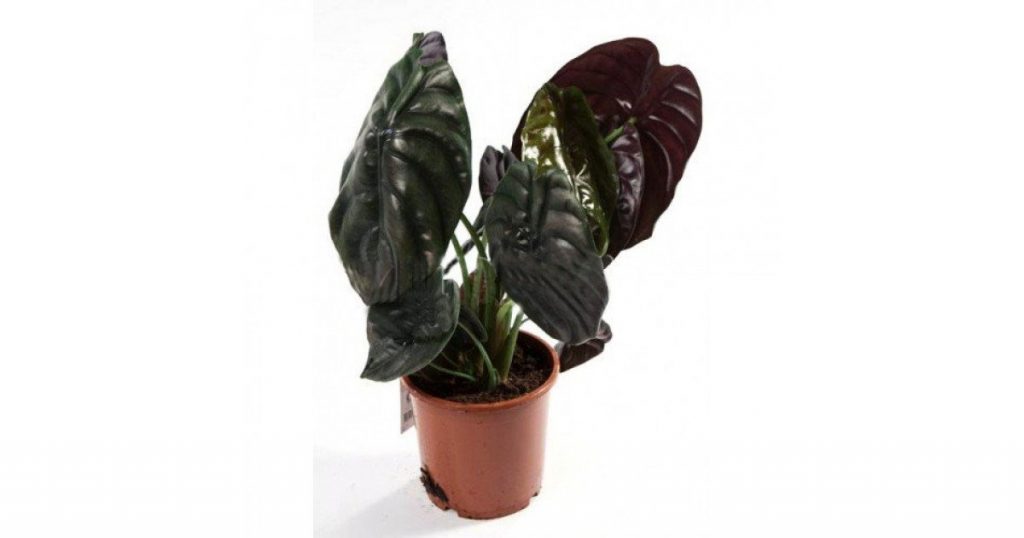
Rooting stem cuttings or cut tops is an option for dying plants. This is a difficult method, as is the rooting of the lower, oldest leaves with a petiole.
After drying and processing the cuts, the cuttings are rooted in the substrate under the cap, under the same conditions as the nodules.
When the Alocasia Wentii is propagated by seeds, varietal characteristics are not preserved, and it is difficult to obtain them.
Seeds are sown freshly harvested, superficially, in greenhouses with a temperature of 23-24 degrees and high humidity. Seedlings dive repeatedly as the roots grow.

